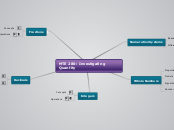da Jayme Beall mancano 8 anni
463
MTE 280 Investigating Quantity

da Jayme Beall mancano 8 anni
463

Più simili a questo
Integers can be added, subtracted, multiplied, and divided. When operating on integers it is important to use different methods to ensure that the operation is being done correctly. For example, using the chip method.
Integers consist of positive and negatives numbers (-3,-2,-1, 0,1,2,3).
Decimals can be added, subtracted, multiplied and divided. When adding and subtracting decimals, it is important to pay attention to the place value and ensure that each digit is being added or subtracted from the corresponding.
Decimals can be represented using base ten blocks. A flat represents 1, a long represents .1, and a unit represents .01. In expanded form, the decimal 54.21 is represented as 5(10)1+4(10)0+2(10)-1+1(10)-2.
Fraction Operations include the standard addition, subtraction, multiplication, and division. Fractions must have common denominators when adding and subtracting. When dividing fractions, you have to multiply by the reciprocal.
A fraction concept includes 3 fractions models. Area/region model, linear model, and set model.
Divisibilty Tests:
2
The ones digit is 0, 2, 4, 6 or 8.
3
The sum of the digits is divisible by 3.
4
The number formed by the last two digits is divisible by 4.
5
The ones digit is 0 or 5.
6
The number is even and the sum of its digits is divisible by 3.
8
The number formed by the last three digits is divisible by 8.
9
The sum of the digits is divisible by 9.
10
The ones digit is 0.
Addition models include: set model (combining 2 separate object sets), and liner model (adding 2 continuous quantities).
Subtraction Models include: Take away (removing a specific amount from an initial quantity), missing addend (determining what quantity needs to be added to reach a target amount), and comparison (determining how much larger or smaller), and linear (using a number line to show the change)
Multiplication models include: repeated addition (set and linear), and area model (representation of a rectangular region).
Division models include: Partition (distributing a set number into equal subsets), and repeated subtraction (create groups of a specified size to determine the number of groups).
The different systems include hindu-arabic, roman, mayan, and babylonian.
Numeration systems can have any amount of bases, for example base 1, 2, 5,10, etc. Each base system has the same amount of digits as its name. This means base 2 has 2 digits 0,1.